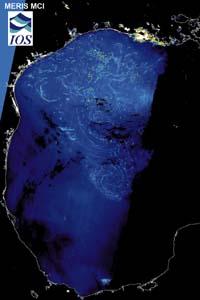Chlorophyll of sargasso from space

The satellite Envisat of the European space agency ESA has detected for the first time from the floating algae space in the Sargasso Sea. These algae are famous because they form nets on the surface of the sea that allow boats to "hunt". The sea of sargasso has taken the name of these hunting algae, which are thus called these floating brown algae. From a biological point of view, flotation allows sargasses to absorb carbon dioxide from the atmosphere and grow through photosynthesis. The satellite Envisat has detected these characteristics.
Precisely, the satellite has sought the footprint of the chlorophyll molecule A in the Sargasso Sea, one of the molecules involved in photosynthesis. This molecule emits light of certain wavelengths through fluorescence, so the search for these light rays allows to detect the plant itself from space.





